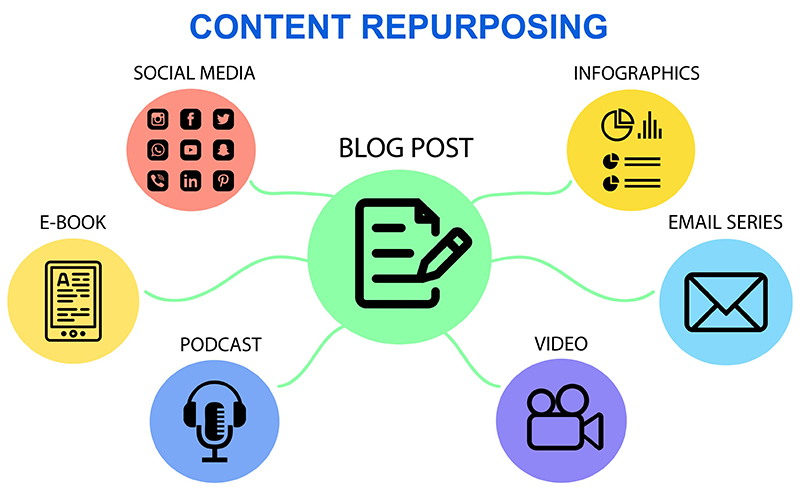You’ve put in the hard work of creating valuable content for your niche site, but now you’re wondering if you can extend its reach to other platforms. Well, the good news is that you absolutely can! Repurposing content is a fantastic way to maximize your efforts and make sure your message is seen by a wider audience. In this article, we’ll explore the various ways you can repurpose your content for different platforms, allowing you to enhance your brand’s visibility and engage with a wider range of people. Whether it’s transforming a blog post into a podcast episode or creating visually appealing infographics from your videos, get ready to discover some creative strategies that will take your content to new heights!
Why Repurposing Content is Important
Content repurposing is a valuable strategy that can benefit businesses and content creators in numerous ways. By repurposing existing content, you can increase reach and engagement, save time and effort, improve SEO, and extend the lifespan of your content.

This image is property of www.fronetics.com.
Increase Reach and Engagement
When you repurpose content, you have the opportunity to reach a wider audience and gain more exposure. By adapting your content to different platforms and formats, you can attract new audiences who may not have come across your original content. For example, repurposing a blog post into a video or podcast episode allows you to tap into different segments of your target audience.
Additionally, repurposing content can increase engagement levels. Some people prefer consuming information in video or audio formats, while others may prefer to read blog posts. By repurposing your content, you provide options for different learning styles and preferences, leading to increased engagement and interaction with your audience.
Save Time and Effort
Creating new and original content can be time-consuming and require significant effort. However, repurposing content allows you to leverage your existing materials, saving both time and effort. Instead of starting from scratch, you can repurpose existing content by adapting it to different formats or presenting it in a new way.
Repurposing content also allows you to extract additional value from your initial investment. By repurposing a single piece of content into multiple formats, you can maximize its potential impact across various platforms, without having to develop completely new ideas from scratch.
Improve SEO
An often-overlooked benefit of repurposing content is its positive impact on search engine optimization (SEO). When you repurpose content, you have the opportunity to optimize it with relevant keywords, meta tags, and other SEO best practices. By doing so, you can improve the visibility and ranking of your content in search engine results pages, attracting more organic traffic to your website or platform.
Furthermore, when you repurpose content, you create more opportunities for backlinks and social shares. This can help increase your content’s authority and credibility, which can further boost its ranking in search engine results.
Extend Content Lifespan
Creating high-quality content requires time, effort, and resources. Therefore, it is essential to maximize the lifespan and value of your content. Repurposing allows you to breathe new life into your existing content by presenting it in different formats or to different audiences.
By repurposing your content regularly, you can ensure that it remains relevant and continues to provide value to your audience over a more extended period. This can help you establish yourself as an authority in your niche and maintain a consistent presence online.
Identifying Platforms for Content Repurposing
Once you understand the importance of repurposing content, you need to identify the platforms where you can repurpose your content effectively. Consider the following platforms for repurposing your content:
Social Media Platforms
Social media platforms offer an excellent opportunity to repurpose your content and reach a wider audience. Platforms like Facebook, Instagram, Twitter, and LinkedIn allow you to share snippets, quotes, or highlights from your existing content. You can also create dedicated posts that link back to your original content, driving traffic and engagement.

This image is property of visme.co.
Blogging Platforms
Repurposing content on blogging platforms involves adapting your existing content into blog posts or guest articles. This allows you to tap into the audience of the blogging platform and establish yourself as a thought leader in your niche. Consider repurposing your podcasts, videos, or social media content into blog posts that expand on the topics covered.
Video Sharing Platforms
Video sharing platforms like YouTube, Vimeo, and TikTok offer an excellent opportunity to repurpose your content visually. You can repurpose blog posts, podcasts, or social media content by creating video content that highlights key points, provides tutorials, or offers a different perspective or format for your audience.
Podcasting Platforms
If you have a blog or video content, repurposing it into podcast episodes can help you tap into the growing podcasting audience. Platforms like iTunes, Spotify, and Soundcloud allow you to share your audio content with a broader audience. Consider adapting your written or video content into audio format, maintaining a conversational tone and engaging storytelling to attract listeners.
Steps to Repurpose Content Effectively
To repurpose content effectively, follow these steps:
Step 1: Evaluate Your Existing Content
Start by evaluating your existing content and identifying pieces that have performed well or have potential for repurposing. Look for evergreen content, which doesn’t have an expiration date, and can provide value to your audience, regardless of when it was created.
Step 2: Define Your Goals and Target Audience
Before repurposing your content, clearly define your goals and identify your target audience. Understanding who you want to reach and what you want to achieve will help you tailor your content repurposing strategy to meet those objectives.

This image is property of static.rfstat.com.
Step 3: Choose the Right Repurposing Methods
Based on your goals and target audience, choose the appropriate repurposing methods and platforms. Consider the formats that resonate with your audience and align with your goals. For example, if your target audience prefers visual content, focus on repurposing into videos or infographics.
Step 4: Adapt and Optimize Content for Each Platform
When repurposing content, it’s essential to adapt and optimize it for each platform or format. Each platform has its own best practices and requirements. Tailor your content to fit the platform’s specific characteristics, such as video length for YouTube or character limits for Twitter.
Step 5: Promote and Share Repurposed Content
Once you’ve repurposed your content, don’t forget to promote and share it across relevant platforms. Leverage your existing audience and utilize appropriate marketing channels to drive traffic and engagement to your repurposed content. Encourage your audience to share, comment, and participate to increase reach and interaction.
Repurposing Methods for Different Platforms
To effectively repurpose content for different platforms, consider the following methods:
1. Social Media Platforms
On social media platforms, repurpose content by creating bite-sized quotes, infographics, or highlight reels from your existing content. Share engaging visuals and snippets that entice users to click through to your original content. Use relevant hashtags and tag influencers or brands to increase reach and engagement.
2. Blogging Platforms
Repurposing content for blogging platforms involves adapting your existing content into written blog posts or guest articles. Expand on the topics covered in your original content and tailor it to the blogging platform’s audience. Include compelling visuals and optimize your content with relevant keywords to improve SEO.

This image is property of quuu.co.
3. Video Sharing Platforms
To repurpose content for video sharing platforms, convert your written content into engaging video content. Create tutorials, animations, or vlogs that provide valuable insights or a new perspective. Utilize visual storytelling techniques to captivate the audience and include calls-to-action to drive traffic back to your original content.
4. Podcasting Platforms
Repurpose your content into podcast episodes by adapting your written or video content into an audio format. Maintain a conversational tone and engage listeners with captivating storytelling. Consider interviewing industry experts or inviting guest speakers to provide fresh insights and attract a wider audience.
Best Practices for Repurposing Content
To ensure successful content repurposing, follow these best practices:
Choose Evergreen Content
When selecting content to repurpose, focus on evergreen topics that will remain relevant and valuable over time. This ensures that your repurposed content continues to provide value to your audience, regardless of when it was initially created.
Maintain Consistent Branding
Maintain consistent branding across all repurposed content to strengthen your brand identity. Use your brand’s colors, logo, and voice throughout the repurposing process. This helps reinforce your brand image and recognition among your audience.
Optimize for Different Formats
Each platform and format have specific requirements and preferences. Optimize your content for each format by adapting it to fit their characteristics. For example, when repurposing blog posts into videos, focus on visually engaging elements and storytelling techniques.

This image is property of sparkgrowth.com.
Maintain Quality and Relevance
Ensure that your repurposed content maintains the same level of quality and relevance as your original content. Avoid diluting your messaging or sacrificing quality for the sake of repurposing. Your repurposed content should be valuable, informative, and engaging to your target audience.
Tools and Resources for Content Repurposing
To streamline your content repurposing efforts, consider utilizing the following tools and resources:
Content Management Systems (CMS)
Content management systems, such as WordPress or HubSpot, can help you organize and repurpose your content efficiently. These platforms allow you to easily edit, schedule, and publish your repurposed content across various platforms.
Video Editing Software
Video editing software, like Adobe Premiere Pro or Final Cut Pro, enables you to repurpose written or audio content into engaging videos. Edit and enhance your videos by adding captions, visuals, transitions, and other effects.
Podcasting Tools
Podcasting tools like Anchor or Audacity simplify the process of repurposing your content into audio format. These platforms offer editing features, hosting capabilities, and distribution options, making it easier to reach a broader audience.
Social Media Management Tools
To effectively manage and distribute your repurposed content across social media platforms, consider using social media management tools like Hootsuite or Sprout Social. These tools allow you to schedule posts, monitor engagement, and track the performance of your repurposed content.
Case Studies: Successful Content Repurposing Examples
Examining successful content repurposing examples can provide valuable insights on effective strategies. Consider the following case studies:
Case Study 1: How XYZ Company Increased Traffic by Repurposing Blog Posts
XYZ Company, a leading tech company, repurposed their blog posts into visually appealing infographics that conveyed key information in a concise and engaging manner. By sharing these infographics on social media platforms, they were able to attract a broader audience and drive more traffic to their website. The repurposed blog posts gained significant social shares and increased their organic reach, resulting in a notable boost in website traffic and brand visibility.
Case Study 2: Leveraging Social Media to Boost Engagement
A fashion retailer leveraged social media platforms to repurpose their existing content. They transformed their blog content into visually stunning, shareable images and short videos, which they shared across various social media platforms. By doing so, they significantly increased engagement levels and drove traffic to their website. The repurposed content led to more shares, likes, comments, and click-throughs, ultimately resulting in higher conversion rates and increased sales.
Common Mistakes to Avoid
To ensure the success of your content repurposing efforts, avoid these common mistakes:
Ignoring Audience Preferences
One common mistake is ignoring the preferences of your target audience when repurposing content. Your repurposed content should align with the formats and platforms your audience prefers. Take the time to understand their preferences and tailor your content accordingly.
Not Adapting Content for Specific Platforms
Failing to adapt your content for specific platforms can hinder its effectiveness. Each platform has unique requirements and characteristics. Adapt your content to fit each platform’s format, constraints, and audience expectations to increase its impact and engagement.
Neglecting SEO Optimization
Ignoring SEO optimization when repurposing content can limit its visibility and organic reach. Optimize your repurposed content with relevant keywords, meta tags, and descriptions. This helps search engines understand the content and improves its ranking in search results.
Lack of Promotion and Distribution Strategy
Simply repurposing content is not enough; you need to actively promote and distribute it across various platforms. Develop a clear promotion and distribution strategy that utilizes relevant marketing channels to maximize the reach and engagement of your repurposed content.
Future Trends in Content Repurposing
As technology continues to evolve, content repurposing is likely to adapt and incorporate new trends. Consider the following future trends in content repurposing:
Artificial Intelligence and Automation
Artificial intelligence (AI) and automation technologies have the potential to revolutionize content repurposing. AI-powered tools can analyze and transform content into different formats automatically, saving time and effort for content creators.
Interactive and Immersive Content
Interactive and immersive content, such as quizzes, polls, or augmented reality experiences, can enhance user engagement and provide a unique repurposing opportunity. By repurposing existing content into interactive formats, you can create more personalized, interactive experiences for your audience.
Integration of Virtual Reality (VR) and Augmented Reality (AR)
The integration of virtual reality (VR) and augmented reality (AR) technologies opens up new avenues for repurposing content. By repurposing existing content into VR or AR experiences, you can offer users more immersive and interactive ways to engage with your brand and content.
Personalized Content Experiences
Personalization will continue to play a crucial role in content repurposing. Tailoring content to individual user preferences and behaviors allows for a more personalized experience. Utilize data and analytics to understand your audience and repurpose content to fit their specific needs and interests.
In conclusion, content repurposing offers numerous benefits, including increased reach and engagement, time and effort savings, improved SEO, and extended content lifespan. By identifying the appropriate platforms, following effective repurposing methods, and adhering to best practices, you can successfully repurpose content and maximize its value. Keep an eye on future trends to stay ahead and continue delivering valuable content experiences to your audience.







